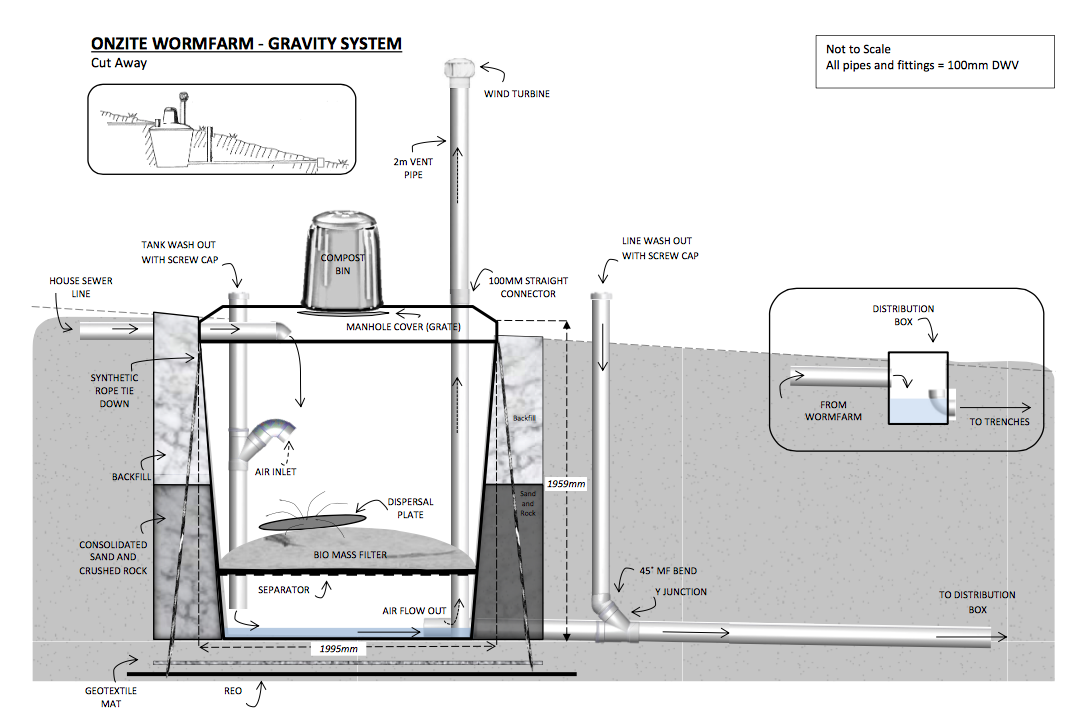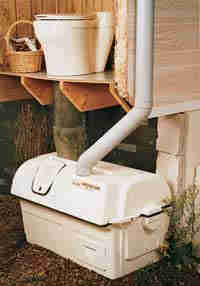The Stinky Issue
One of the considerations of going off the grid is what to connect the toilet and other grey/black waters sytems to. Many in country areas have been using septic tank systems for years. But what is the best solution from both an ecological perspective and a economical perspective?
The Choices
- Conventional Septic
- Aerated treatment system
- Worm assisted Treatment
- Dry Composting
Since there are several different options available I will go through the pros and cons that we looked at and why we made the decision that we did.
Conventional Septic
In the convetional Septic system, a treatment tank takes all the waste black water (and grey if nescessary) and using anaerobic bacteria. This type of bacteria are not very effecient in terms of waste water processing. They usually smell as soon as the PH conditions are not perfect. Septic systems contribute to large amounts of ground water contamination in Australia.The pros for using a septic system include the cost, the ease for council approval and the reliablity. The cost can hardly be beaten except by a home built dry composting system. Our local council in the Bland Shire (NSW) is used to dealing with septic systems and don't bat an eye at them. As long as large amounts of chemicals are kept out of the septic system, they will just quitely keep going for years without much maintenance. After about 5 years the sludge will need to be pumped out, depending on how many people using the system and the amount of water going through it.
The cons for the Septic System are the fact that the output water from it must be disposed of by a sub-surface drainage pit. The water is actually quite toxic as it has large amounts of bacteria and other types of cytoplasms. This water in our dry climate is being wasted. Also our very clayey soil content does not allow the leaching pits to work very well. In wet seasons the pits will back up quite badly. A alternative solution is to use a transpiration pit that deliberatly tries to use evaoporation to dispell the water. This is usually assisted by non-edible plants and trees.
Aerated Treatment System
The Aerated Treatments System (ATS)is the newer type of micro-treatment plants used on households in most parts of the world today. They use both aerobic and aneraobic bacteria to decomopose the waste matter. Some of the better designs are also able to reduce the nitrogen output by large amounts through the use of nitrifiying bacteria. The pros for using a ATS include:
- Much greater benefits for environment
- Can use water output for non-edible plants
- Dosen't Smell
The cons of using a ATS system include:
- The cost of commercial Systems
- The ongoing maintenance
- They are less reliable due to careful balances in the chambers between different bacteria
Due to my background in wastewater treament I did consider building my own system. Under the NSW health regulations a person is allowed to build their own test system. It must be properly designed for the loads it handles, it must be shown by laboritory testing to have safe output levels of fecal count and nitrogen levels. A maintenance manual must be written. The designer is then allowed to maintain they system to the written specificaitons. However due to the size of the rest of the project I decided I didn't really have enough time to do this.
Worm Assisted Treatment

The idea of worm assisted treatment is realitively new in Australia. Some of the large plants have developed a method of using composting worms to very effectively treat large amounts of waste. The idea is that as the worms work their way through the process matter, they kill the bad bacteria and promote good bacteria through their guts. They also make the way for oxygen to enter the mass promoting aerobic bacteria (good ones). The idea has made its way to smaller septic tank sized systems too. The thing about worms is that there is a few specific conditions they like to be able to thrive.
- Stable temperature around 20 degree mark
- Not too wet and not too dry
- A balanced PH
These aren't huge factors. Generally these systems are made from converted septic tanks. A grate is setup on the bottom to allow a mass to accumulate on top. Any wastewater as a liquid enters the mass, but quickly seperates the liquid to the bottom of the tank where it is pumped to a tricking filter or transpiration pit. The worms can then easiy work on the remaining mass. Worms are very effecient. This will mean less pump-outs over the life of the system. Also the system does not smell. The system is also much safer for the environment. Here is a link to a onzite commercial wormfarm
Dry Composting

The concept of dry-composting toilets has been around for a long time. Many people think of the under-sized, under-maintained national park long drops as dry-composting toilets. Usually such sites are not situated properly or under-sized for the usage they get.
A properly designed dry composting toilet is smell-free, easy to maintain, environmentally friendly and economical. People may wonder what the council says about dry-composting toilets. Basically they want you to use an approved type that has been licensed. These can work well. There is a way, if you are capable of doing the design, where you can design and build one yourself, as long as you show you have designed it yourself. You must be able to show it complies with Australian Standards and meets the requirements for NSW health. It also must have a maintenance manual and be properly disposed of in an approved way. You will still need a permit to operate it from your local council
Our Choice
Due to financial and time restraints we have chosen to take the septic tank route for now. I have chosen to use a transpiration pit to alleviate the drainage issue into our clayey soil. In the future I would like to convert it to a worm based system.